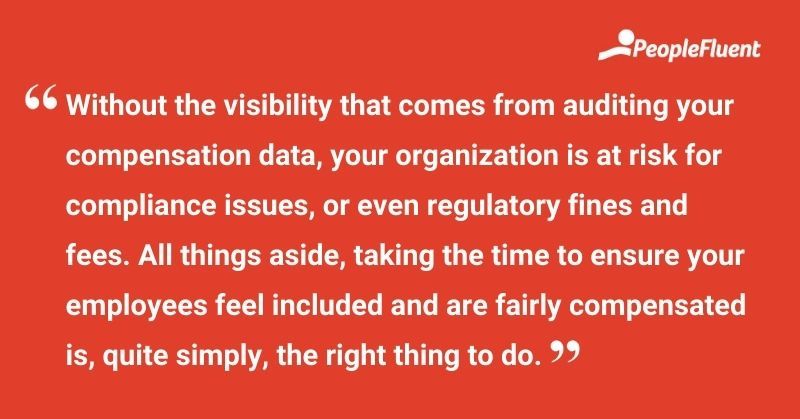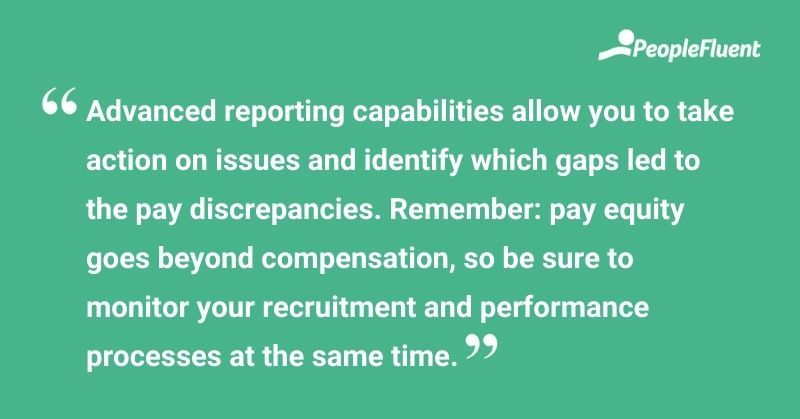Published: Aug 11, 2021Time to read: 5mins Category: Compensation
Driving DE&I With Compensation: How Analytics and Reporting Can Help
Everyone wants to be paid fairly but are they truly getting the salary they’re worth? When it comes to compensation reviews and audits, getting it “just right” isn’t just a Goldilocks-like fairy tale. If you have access to robust analytics, your leaders can create and review reports that show how employees are being fairly and equitably rewarded—regardless of race, sexuality, age, gender, or other factors. Read on to find out how.
Getting diversity, equity, and inclusion (DE&I) right is more important than ever. While it’s refreshing to see the long-overdue change gaining momentum, recent research shows there’s still work to be done. Only 15-20% of S&P 500 companies include DE&I metrics in their executive incentive plans.
How can these organizations do better?
In short, you need visibility into where you are today, to know what needs to be changed. But where does this data come from and how can it be used to create change? Let’s dive into how your compensation planning tool (when complete with analytics and reporting features) can be the spark that drives DE&I across your company.
MORE FROM THE BLOG | ‘The Real Cost of Pay Inequality: More Than Just $160 Trillion’
Measure Inclusivity and Representation
Having effective programs, plans, and policies in place creates greater diversity in your workforce. On the flip side, if you don’t have these set up—and need to design new programs—measuring inclusivity and representation is a good starting point.
Before we dive into how a compensation planning tool can help with this, here’s Deloitte’s model for inclusivity. We think it’s a great summary of what inclusivity means:
- Being treated with fairness and respect
- Feeling valued and belonging to the group
- Feeling safe to contribute openly
- Being empowered to grow and achieve
You can measure this by adding inclusion-based questions to the regular pulse surveys that your HR department sends out. When combined with data from your compensation programs, you can identify opportunities to create equitable pay practices. Start asking important questions like:
- What is the variation for pay within different ethnic groups?
- How do budgeted salary increases compare for male and female employees?
- What is the variation in pay within the salary band based on age and tenure?
Keep in mind that using manual tools—like spreadsheets—leaves your organization open to human error. Unchecked, these random errors can result in incorrect employee pay. Without the visibility that comes from auditing your data, your organization is at risk for compliance issues, or even regulatory fines and fees.
All things aside, taking the time to ensure your employees feel included and are fairly compensated is, quite simply, the right thing to do.

KEEP READING | ‘5 Benefits and Must-Have Features of a Compensation Solution’
Ensure Pay Equity
Since 1997, there have been 1,000 pay discrimination cases each year under the U.S. Equal Pay Act. If you want to be more inclusive, you need to start paying employees fairly. This is much easier to do when you have the right tools to help you gather the necessary data. Reporting and analytics features will help you to perform a pay equity audit. Data can be pulled from the compensation tool so you have more insight into things like:
- Salary bands
- Job roles
- Gender
- Ethnicity groups
- Age
- Employee tenure
Be on the lookout for potential treatment that may be deemed discriminatory. A thorough audit is also important as it lets you compare the pay your employees receive for doing the same work as others in the business.
Once you’ve accounted for differences (like work experience and job performance), it’s time to look at any pay differences that can’t be justified with data. These advanced reporting capabilities allow you to take action on issues and identify which gaps led to the pay discrepancies.
Remember: pay equity goes beyond compensation, so be sure to monitor your recruitment, and performance processes at the same time.

RELATED CONTENT | ‘Workplaces That Work: How to Create a Culture That Embraces Pay Equity’
Start Making The Data Talk
You can’t fix a problem if you don’t know it exists!
That’s why it’s important to know what data you currently have available to you. And, which areas of the business you could add to this set—giving you a wider view of potential pitfalls. For example, if employees are leaving a specific department for no other reason than pay, especially employees with protected characteristics, start investigating why.
Another thing to consider: not all of your line managers will be well versed on fair pay practices and how they can adhere to them. This presents the chance to offer new training initiatives geared toward DE&I and performance-based pay practices.
Managers play a big role in employees receiving rewards, bonuses, and raises. Don’t let discretion get in the way of pay equity and inclusivity. Talk with your HR and L&D teams so they can develop a plan using facts and data—one that will help guide your managers when they’re making those all-important pay decisions.
GO DEEPER INTO DE&I WITH THIS GUIDE FROM OUR SISTER COMPANY, AFFIRMITY | ‘Inclusion Drives Diversity: Harnessing Inclusive Policies as an Engine for Organizational Change’
Keep the Compensation Conversation Moving
Ready to see why analytics are necessary for creating a culture of fairness and inclusion while also remaining competitive? Download your free copy of ‘The Ultimate Compensation Buyers’ Guide for Compensation Management’ for more, or get in touch for a demo.